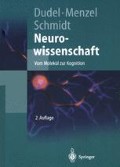Zusammenfassung
Licht hat sowohl Quanten- als auch Wellencharakter (Dualismus von Welle und Korpuskel). Je nach Versuchsanordnung wird die eine oder die andere Eigenschaft wirksam: Wann immer Licht absorbiert wird, z.B. im Sehfarbstoff-Molektil, läßt sich dies als Quantenprozeß beschreiben. Wird mittels Licht dagegen ein Objekt z. B. durch ein Linsensystem abgebildet, so ermöglicht die Vorstellung von Licht als einer transversalen Welle die quantitative Behandlung der Phänomene. Aus dem riesigen Wellenlängenbereich elektromagnetischer Strahlung, der von der Sonne die Erde erreicht, wird von Mensch und Tier nur ein kleiner Ausschnitt — Wellenlängen von etwa 300 nm (ultraviolett) bis 750 nm (rot) — zum Sehen ausgenutzt. Fär die Einschränkung auf diesen Wellenlängenbereich gibt es verschiedene plausible Gründe. För die Begrenzung am kurzwelligen Ende des Spektrums gelten im wesentlichen drei:
-
(1)
Die Quantenzahl der Strahlung im ultraviolett en Spektralbereich, die an der Erdoberfläche ankommt, ist relativ gering (Abb. 17-1a). Die Sonne als Strahler von etwa 6000° K strahlt relativ wenig UV-Licht ab. Zusätzlich wird das Licht in der Atmosphäre vor all em durch die Absorptionsbanden des Ozons stark geschwächt und bis zu einer Wellenlänge von etwa 300 nm fast völlig unterdrückt. Die Streuung des Lichtes an Luftmolekülen sorgt außerdem für beträchtliche Veränderungen im Spektrum des auf der Erdoberfläche ankommenden Lichtes.
-
(2)
Augenmedien streuen Licht. Die Streuung ist dabei urn so stärker, je kürzer die einfallende Wellenlänge ist. Bei großen Augen mit langen optischen Wegen wie dem des Menschen wirkt sich die Lichtstreuung besonders stark aus (Abb. 17-1b). UV-Sehen ist deshalb Bur bci Tieren mit relativ kleinen Augen zu erwarten und bisher auch nur da gefunden worden.
-
(3)
Kurze UV-Strahlung führt zu Fluoreszenz der Augenmedien (Linsen, Glaskörper) und wird damit zum Sehen unbrauchbar, weil dieses Fluoreszenzlicht keine Information über die Helligkeitsverteilung in der Umwelt enthält, sondern im Gegenteil den Bildkontrast auf der Retina reduziert und damit die Qualität des Bildes beeinträchtigt.
Access this chapter
Tax calculation will be finalised at checkout
Purchases are for personal use only
Preview
Unable to display preview. Download preview PDF.
Literatur
Weiterführende Lehr- und Handbücher
Autrum H, Jung R, Loewenstein WR, MacKay DM, Teuber HL (1971-1981) Handbook of sensory physiology, vols 1-9. Springer, Berlin
Campenhausen C von (1993) Die Sinne des Menschen. Thieme, Stuttgart
Cronly-Dillon J (1991) Vision and visual dysfunction, vols 1-17. Macmillan, London
Lythgoe JN (ed) (1979) The ecology of vision. Clarendon, Oxford
Rodieck RW (ed) (1973) The vertebrate retina. Freeman, San Francisco
Snyder AW, Menzel R (eds) (1975) Photoreceptor optics. Springer, Berlin
Einzel- und Übersichtsarbeiten
Campenhausen C von (1986) Photoreceptors, lightness constancy and color vision. Naturwissenschaften 73:674
Dartnall HJA, Bowmaker JK, Mollon JD (1983) Human visual pigments: microspectrophotometric results from the eyes of seven persons. Proc R Soc Lond [Biol] 220:115–130
Exner S (1891) Die Physiologie der facettierten Augen von Krebsen und Insekten. Deuticke, Leipzig
Fischer AJ, McGuire JJ, Schaeffel F, Stell WK (1999) Light-and focus-dependent expression of the transcription factor ZENK in the chick retina. Nature Neurosci 2:706–712
Frisch K von (1965) Tanzsprache und Orientierung der Bienen. Springer, Berlin
Hamdorf K (1979) The physiology of invertebrate visual pigment. In: Autrum H (ed) Invertebrate photoreceptors. Springer, Berlin, p 145 (Handbook of sensory physiology, vol 7/6A: Comparative physiology and evolution of vision in invertebrates)
Hecht S, Shlaer S, Pirenne MH (1942) Energy, quanta and vision. J Gen Physiol 25:819–840
Kirschfeld K (1971) Aufnahme und Verarbeitung optischer Daten im Komplexauge von Insekten. Naturwissenschaften 58:201–209
Kirschfeld K (1976) The resolution of lens and compound eyes. In: Zettler F, Weiler R (eds) Neural principles in vision. Springer, Berlin, pp 354–370
Kirschfeld K (1983) Are photoreceptors optimal? TINS 6:97–101
Kirschfeld K (1984) Linsen-und Komplexaugen: Grenzen ihrer Leistung. Naturwiss Rundsch 37:352–362
Kirschfeld K (1990) Genetisch manipulierte Sehfarbstoffe von Drosophila. Naturwiss Rundsch 43:55–61
Kunze P (1979) Apposition and superposition eyes. In: Autrum H (ed) Invertebrate photoreceptors. Springer, Berlin, p 441 (Handbook of sensory physiology, vol 7/6A: Comparative physiology and evolution of vision in invertebrates)
Land MF (1991) Optics of the eyes of the animal kingdom. In: Cronly-Dillon JR, Gregory RL (eds) Evolution of the eye and visual system. Macmillan, London, p 118 (Vision and visual dysfunction, vol 2)
Laughlin S (1981) Neural principles in the peripheral visual systems of invertebrates. In: Autrum H (ed) Invertebrate visual centers and behavior I. Springer, Berlin, p 133 (Handbook of sensory physiology, vol 7/6B: Comparative physiology and evolution of vision in invertebrates)
Menzel R, Backhaus W (1991) Colour vision in insects. In: Gouras P (ed) The perception of colour. Macmillan, London, p 262 (Vision and visual dysfunction, vol 6)
Mollon J (1992) Worlds of difference. Nature 356:378–379
Müller F, Kaupp UB (1998) Signaltransduktion in Sehzellen. Naturwissenschaften 85:49–61
Neumeyer C (1991) Evolution of colour vision. In: Cronly-Dillon JR, Gregory RL (eds) Evolution of the eye and visual system. Macmillan, London, p 284 (Vision and visual dysfunction, vol 2)
Vogt K (1980) Die Spiegeloptik des Flußkrebsauges. J Comp Physiol 135:1–19
Vogt K, Kirschfeld K (1984) Chemical identity of the chromophores of fly visual pigment. Naturwissenschaften 71:211–212
Wäßle H (1984) Auge und Gehirn: Informationsverar-beitung im visuellen System der Säugetiere. In: Karlson P et al. (Hrsg) Information und Kommunikation. Naturwissenschaftliche, Medizinische und Technische Aspekte. Wissenschaftliche Verlagsgesellschaft, Stuttgart, S 227
Zuker CS, Cowman AF, Rubin OM (1985) Isolation and structure of a rhodopsin gene from D melanogaster. Cell 40:851–858
Editor information
Editors and Affiliations
Rights and permissions
Copyright information
© 2001 Springer-Verlag Berlin Heidelberg
About this chapter
Cite this chapter
Kirschfeld, K. (2001). Photorezeption (periphere Sehorgane). In: Dudel, J., Menzel, R., Schmidt, R.F. (eds) Neurowissenschaft. Springer-Lehrbuch. Springer, Berlin, Heidelberg. https://doi.org/10.1007/978-3-642-56497-0_17
Download citation
DOI: https://doi.org/10.1007/978-3-642-56497-0_17
Publisher Name: Springer, Berlin, Heidelberg
Print ISBN: 978-3-642-62534-3
Online ISBN: 978-3-642-56497-0
eBook Packages: Springer Book Archive

